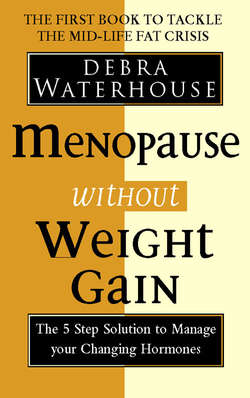Читать книгу Menopause Without Weight Gain: The 5 Step Solution to Challenge Your Changing Hormones - Debra Waterhouse - Страница 8
The Life Cycle of a Female Fat Cell
ОглавлениеEach of your 30 billion female fat cells (that’s right, 30 billion!) came into this world programmed with specific instructions. As soon as they figured out that they were female, with two X chromosomes, they knew that they would have an exciting life ahead of them, filled with activity and opportunity. They would have the power to store fat every single day, but especially during the three stages of female passage: puberty, pregnancy and the transition to the menopause.
I realize that puberty seems like a lifetime ago, and any pregnancies may be in the past (or maybe not, since more women are having children during the perimenopause), but it’s important to understand the specialized function of female fat cells throughout your life. The survival of the human race is dependent on our efficient, smart, stubborn fat cells, which were activated at puberty, given more power with pregnancy and then turbo-charged during the perimenopause.
Do you remember what happened to your body during puberty? The surge of oestrogen awakened the fat cells in your breasts, buttocks, hips and thighs – and you were given a womanly, pear-shaped body. This was your fat cells’ first major assignment, and they didn’t want to disappoint you. They needed to store enough fat for menstruation to start, then they needed to store even more to make sure enough fat was packed away to survive a potential famine. Through thousands of years of evolution, your fat cells learned that the larger they grew during puberty, the more calories you would have on reserve to survive a famine, drought or other catastrophe. And just in case you were pregnant when this pending famine hit, their goal was to make sure both you and your developing child were protected.
Then, if and when you actually did get pregnant, high oestrogen levels brought the power of your fat cells to new heights. During the entire nine months of pregnancy, your fat cells were busy storing as much fat as possible to further protect and cushion the foetus. And after you delivered your child, your fat cells were congratulating themselves on a job well done.
We have all gone through the first stage of fat storage with puberty, many of us have gone through the second stage with pregnancy (some for repeated encores), and all of us will go through the third stage with the menopause. But the process is markedly different. A surge in oestrogen doesn’t cause more weight gain; a drop in oestrogen does.
During the menopause, many women come to the conclusion that they should be losing weight because they no longer need all that extra fat for fertility and pregnancy. When that feared famine hits, they need only enough stored fat for one person to survive, not potentially two.
Their rationale makes sense: If oestrogen stimulates fat storage, then the decreased oestrogen levels during the perimenopause should cause weight loss, not weight gain. One would think. But the midlife fat cell is so resourceful that it finds other reasons and other ways to store fat. Now that you are a bit older, your fat cells want to make sure that you not only survive, but also live a long, healthy life. They are worried that a disease or disability may strike in the upcoming years which causes substantial weight loss and weakness. Even more important, they are concerned with your quality of life today. An amazing phenomenon occurs during the menopause: To smooth your transition, balance your body, stabilize your moods and enhance your well-being, your fat cells grow larger to start producing oestrogen for you.
To fulfill this life-enhancing duty, they quickly activate more of the enzymes which store fat, deactivate the enzymes that release it, and expand by at least 20 per cent. If you were to look at a female fat cell under a microscope, this is what it would look like before and during the transition to the menopause:
(The arrows in this and all diagrams illustrate the enzymes that store and release fat. They do not reflect the exact number of enzymes; they are to help you visualise how female fet cells function)
In summary, this is the healthy and necessary life cycle of a female fat cell:
Your premenopausal fat cells may have been smart and stubborn, but your menopausal fat cells are ingenious. It’s their last chance to get as big and plump as they possibly can. I can’t predict exactly when the IQ of your fat cells will skyrocket and you’ll enter this transition or exactly how powerful and big your fat cells will become. We are all different. But what I do know is that the transition starts in your mid-to late thirties, gains force through your forties, and tapers off in your mid-to late fifties. We all follow a similar timeline.
